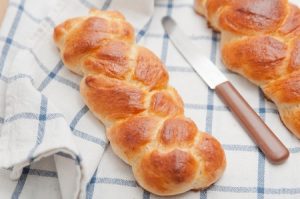
Challah has been a staple at our tables since the creation of Judaism. The symbolism of Challah goes deeply into religion and spiritualism, and has evolved to encompass different meanings over time. Tradition states that the each Sabbath meal (Friday, Saturday, Sunday), as well as two holiday meals begin with two loaves of Challot each. The manna is symbolic of the bread that was supplied by G-d after our Jewish ancestors wandered the desert for 40 years after the Exodus of Egypt.
Usually you will see Challah bread woven and braided into round loaves. Traditional Challah will have what adds up to 12 strands, representing the twelve tribes. The loaves represent the promise that G-d will provide for his people. Many times, bakers will choose to sprinkle their Challah bread with seeds. Poppy, Sesame, or coriander all represent the bread falling from heaven.
The Shapes of Challah
In addition to the traditional woven loaves that you see, there are a variety of shapes and designs that Challah bread has embraced for special occasions. You’ll see spiral rounds, which represent the continuity of creation. Braided circles represent the journey to heaven. Crowns represent G-d’s rule over his people. Challah can also be in the shape of a bird, which when eaten on Yom Kippur is tied to a passage from Isaiah 31:5, “As hovering birds, so will the Lord of hosts shield Jerusalem”. It is symbolic of prayers reaching the heavens.
The Best Challah Bread Recipe
The best challah breads are homemade from scratch. Here is a tried and true recipe that perfectly makes two loaves.
Ingredients:
- 1/3 cup of honey
- 1 ¼ cups warm water
- 2 ¼ teaspoons active dry yeast
- 1 ½ teaspoons of salt
- 2/3 cup olive oil
- 2 eggs
- 5 cups of unbleached flour, plus more as needed
- ¼ cup milk
- 1 egg white
- 2 tablespoons olive oil
- 1 tablespoon white sugar
Directions
First, dissolve honey, yeast, and water into a large mixing bowl. Set aside this mixture for about 15 minutes, until the yeast forms a creamy layer.
Then, mix in the salt, olive oil, and beaten eggs.
Gently add 1 cup of flour at a time until the dough is tacky. It shouldn’t be sticky-wet. If you still have stickiness, add a bit more flour.
Turn the dough onto a floured surface and knead it until you have a smooth, elastic loaf. This will take about 10 minutes.
Lightly oil a bowl and insert the ball of kneaded dough. Make sure the surface of the dough is covered in oil before you allow it to rise.
Leave the dough in the bowl, covered in a warm place for about an hour and half.
Once the dough has fully risen, take it out of the bowl and divide it into two separate loaves.
For directions on braiding your Challot bread, watch the video below. You’ll find directions on how to do a simple braid, all the way up to 9 strands.
Once your Challah is braided as you please, preheat your oven to 350 degrees F.
Place your braided Challah onto a baking sheet lined with parchment.
Create a glaze by whisking together the egg whites, milk, 2 table spoons of olive oil, and the sugar. Brush the glaze over top of the Challah. This will give it a beautiful shiny finish once it’s done baking.
Bake for about 30 minutes, or until it has reached a nice, golden brown color.
